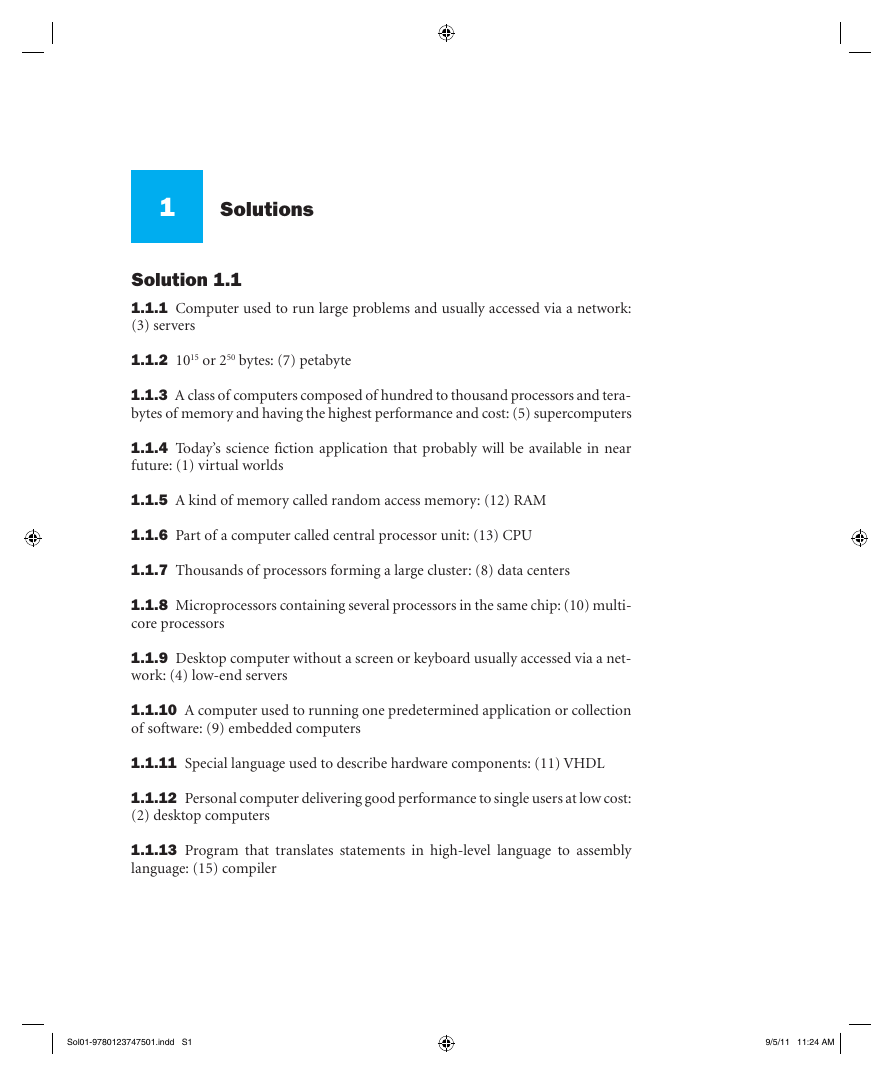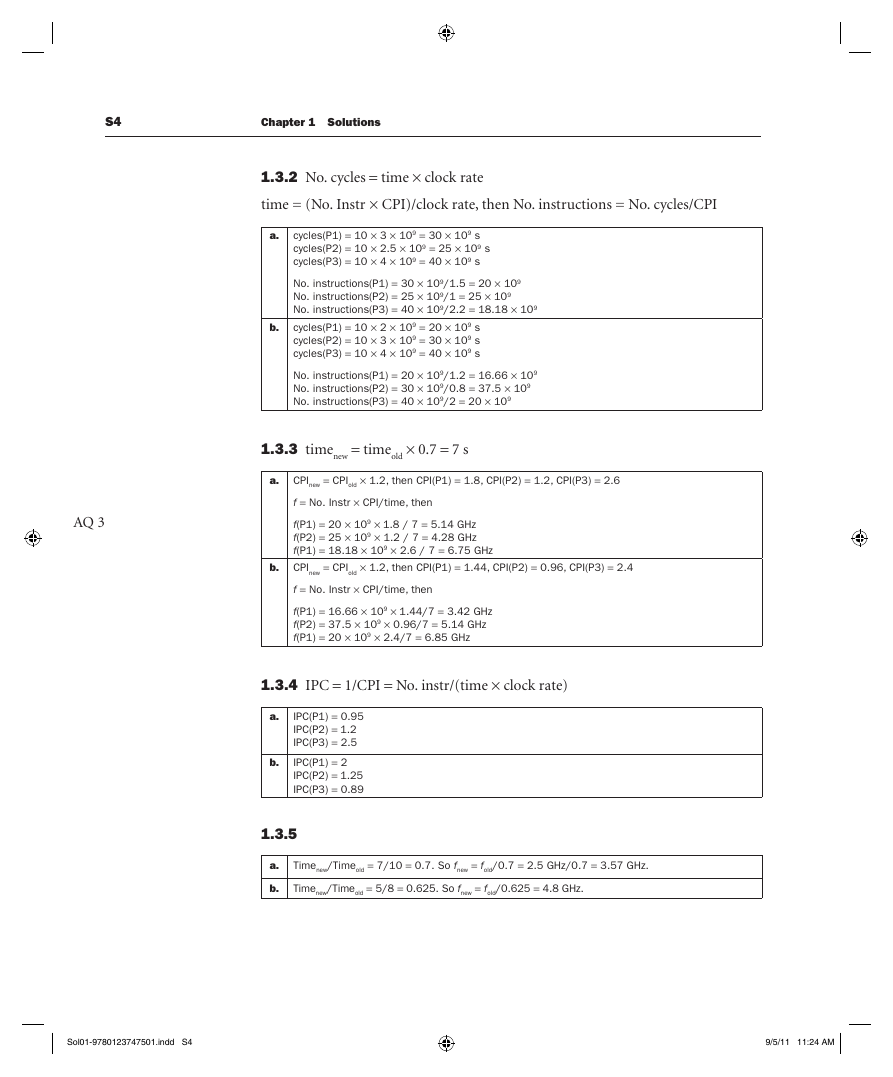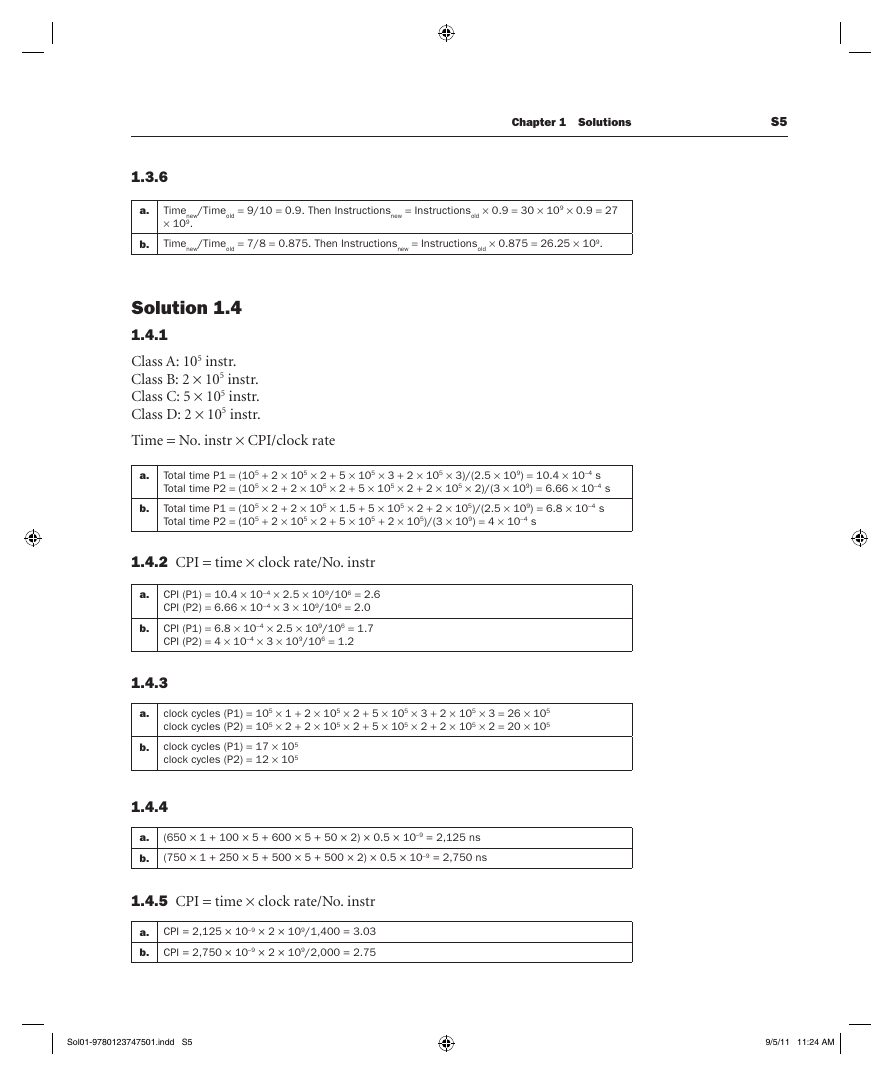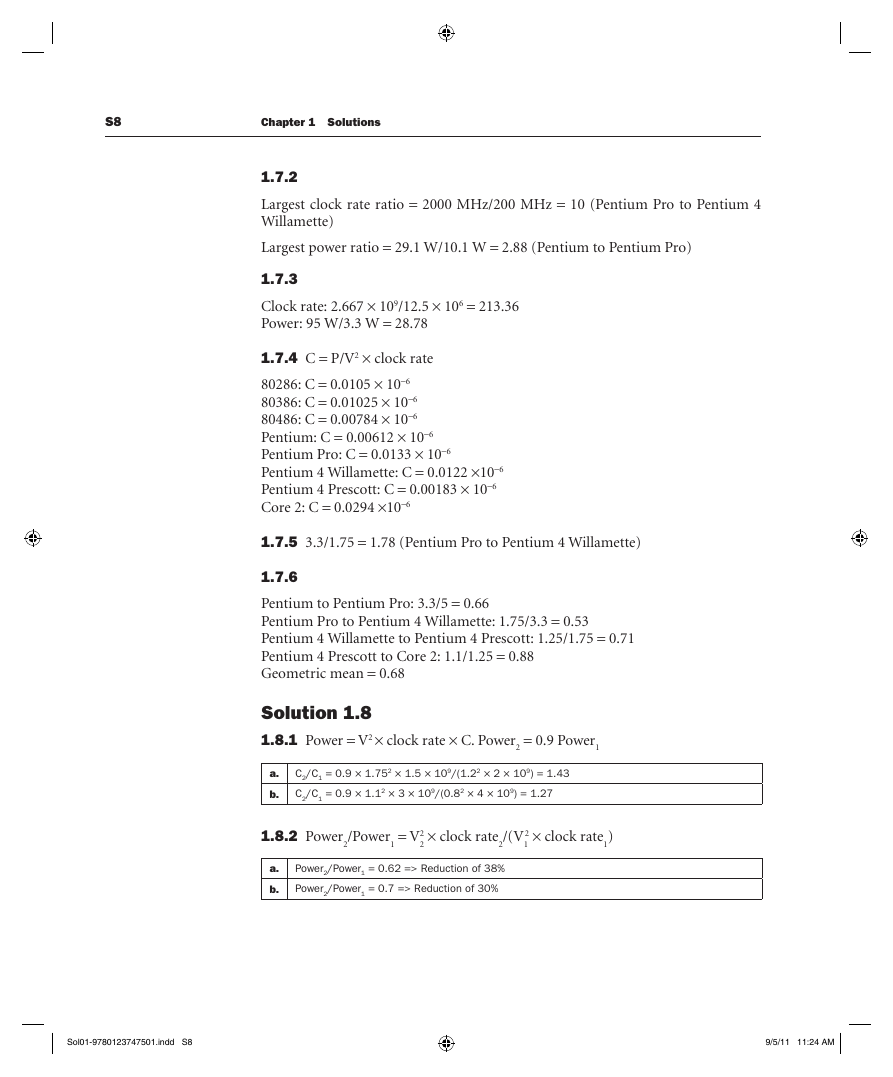1
Solutions
Solution 1.1
1.1.1 Computer used to run large problems and usually accessed via a network:
(3) servers
1.1.2 1015 or 250 bytes: (7) petabyte
1.1.3 A class of computers composed of hundred to thousand processors and tera-
bytes of memory and having the highest performance and cost: (5) supercomputers
1.1.4 Today’s science fi ction application that probably will be available in near
future: (1) virtual worlds
1.1.5 A kind of memory called random access memory: (12) RAM
1.1.6 Part of a computer called central processor unit: (13) CPU
1.1.7 Thousands of processors forming a large cluster: (8) data centers
1.1.8 Microprocessors containing several processors in the same chip: (10) multi-
core processors
1.1.9 Desktop computer without a screen or keyboard usually accessed via a net-
work: (4) low-end servers
1.1.10 A computer used to running one predetermined application or collection
of software: (9) embedded computers
1.1.11 Special language used to describe hardware components: (11) VHDL
1.1.12 Personal computer delivering good performance to single users at low cost:
(2) desktop computers
1.1.13 Program that translates statements in high-level language to assembly
language: (15) compiler
Sol01-9780123747501.indd S1
Sol01-9780123747501.indd S1
9/5/11 11:24 AM
9/5/11 11:24 AM
�
S2
Chapter 1 Solutions
1.1.14 Program that translates symbolic instructions to binary instructions:
(21) assembler
1.1.15 High-level language for business data processing: (25) Cobol
1.1.16 Binary language that the processor can understand: (19) machine language
1.1.17 Commands that the processors understand: (17) instruction
1.1.18 High-level language for scientifi c computation: (26) Fortran
1.1.19 Symbolic representation of machine instructions: (18) assembly language
1.1.20 Interface between user’s program and hardware providing a variety of
services and supervision functions: (14) operating system
1.1.21 Software/programs developed by the users: (24) application software
1.1.22 Binary digit (value 0 or 1): (16) bit
1.1.23 Software layer between the application software and the hardware that
includes the operating system and the compilers: (23) system software
1.1.24 High-level language used to write application and system software: (20) C
1.1.25 Portable language composed of words and algebraic expressions that must
be translated into assembly language before run in a computer: (22) high-level
language
1.1.26 1012 or 240 bytes: (6) terabyte
Solution 1.2
1.2.1 8 bits × 3 colors = 24 bits/pixel = 3 bytes/pixel.
AQ 1
a.
b.
Confi guration 1: 640 × 480 pixels = 179,200 pixels => 179,200 × 3 = 537,600 bytes/frame
Confi guration 2: 1280 × 1024 pixels = 1,310,720 pixels => 1,310,720 × 3 = 3,932,160
bytes/frame
Confi guration 1: 1024 × 768 pixels = 786,432 pixels => 786,432 × 3 = 2,359,296
bytes/frame
Confi guration 2: 2560 × 1600 pixels = 4,096,000 pixels => 4,096,000 × 3 = 12,288,000
bytes/frame
Sol01-9780123747501.indd S2
Sol01-9780123747501.indd S2
9/5/11 11:24 AM
9/5/11 11:24 AM
�
Chapter 1 Solutions
S3
1.2.2 No. frames = integer part of (Capacity of main memory/bytes per frame)
a.
b.
Confi guration 1: Main memory: 2 GB = 2000 Mbytes. Frame: 537.600 Mbytes => No. frames = 3
Confi guration 2: Main memory: 4 GB = 4000 Mbytes. Frame: 3,932.160 Mbytes => No. frames = 1
Confi guration 1: Main memory: 2 GB = 2000 Mbytes. Frame: 2,359.296 Mbytes => No. frames = 0
Confi guration 2: Main memory: 4 GB = 4000 Mbytes. Frame: 12,288 Mbytes => No. frames = 0
1.2.3 File size: 256 Kbytes = 0.256 Mbytes.
Same solution for a) and b)
Confi guration 1: Network speed: 100 Mbit/sec = 12.5 Mbytes/sec. Time = 0.256/12.5 = 20.48 ms
Confi guration 2: Network speed: 1 Gbit/sec = 125 Mbytes/sec. Time = 0.256/125 = 2.048 ms
AQ 2
1.2.4
a.
b.
2 microseconds from cache ⇒ 20 microseconds from DRAM.
2 microseconds from cache ⇒ 20 microseconds from DRAM.
1.2.5
a.
b.
2 microseconds from cache ⇒ 2 ms from Flash memory.
2 microseconds from cache ⇒ 4.28 ms from Flash memory.
1.2.5
a.
b.
2 microseconds from cache ⇒ 2 s from magnetic disk.
2 microseconds from cache ⇒ 5.7 s from magnetic disk.
Solution 1.3
1.3.1 P2 has the highest performance.
Instr/sec = f/CPI
a.
b.
performance of P1 (instructions/sec) = 3 × 109/1.5 = 2 × 109
performance of P2 (instructions/sec) = 2.5 × 109/1.0 = 2.5 × 109
performance of P3 (instructions/sec) = 4 × 109/2.2 = 1.8 × 109
performance of P1 (instructions/sec) = 2 × 109/1.2 = 1.66 × 109
performance of P2 (instructions/sec) = 3 × 109/0.8 = 3.75 × 109
performance of P3 (instructions/sec) = 4 × 109/2 = 2 × 109
Sol01-9780123747501.indd S3
Sol01-9780123747501.indd S3
9/5/11 11:24 AM
9/5/11 11:24 AM
�
S4
Chapter 1 Solutions
1.3.2 No. cycles = time × clock rate
time = (No. Instr × CPI)/clock rate, then No. instructions = No. cycles/CPI
AQ 3
a.
b.
cycles(P1) = 10 × 3 × 109 = 30 × 109 s
cycles(P2) = 10 × 2.5 × 109 = 25 × 109 s
cycles(P3) = 10 × 4 × 109 = 40 × 109 s
No. instructions(P1) = 30 × 109/1.5 = 20 × 109
No. instructions(P2) = 25 × 109/1 = 25 × 109
No. instructions(P3) = 40 × 109/2.2 = 18.18 × 109
cycles(P1) = 10 × 2 × 109 = 20 × 109 s
cycles(P2) = 10 × 3 × 109 = 30 × 109 s
cycles(P3) = 10 × 4 × 109 = 40 × 109 s
No. instructions(P1) = 20 × 109/1.2 = 16.66 × 109
No. instructions(P2) = 30 × 109/0.8 = 37.5 × 109
No. instructions(P3) = 40 × 109/2 = 20 × 109
1.3.3 timenew = timeold × 0.7 = 7 s
a.
b.
CPInew = CPIold × 1.2, then CPI(P1) = 1.8, CPI(P2) = 1.2, CPI(P3) = 2.6
f = No. Instr × CPI/time, then
f(P1) = 20 × 109 × 1.8 / 7 = 5.14 GHz
f(P2) = 25 × 109 × 1.2 / 7 = 4.28 GHz
f(P1) = 18.18 × 109 × 2.6 / 7 = 6.75 GHz
CPInew = CPIold × 1.2, then CPI(P1) = 1.44, CPI(P2) = 0.96, CPI(P3) = 2.4
f = No. Instr × CPI/time, then
f(P1) = 16.66 × 109 × 1.44/7 = 3.42 GHz
f(P2) = 37.5 × 109 × 0.96/7 = 5.14 GHz
f(P1) = 20 × 109 × 2.4/7 = 6.85 GHz
1.3.4 IPC = 1/CPI = No. instr/(time × clock rate)
a.
b.
IPC(P1) = 0.95
IPC(P2) = 1.2
IPC(P3) = 2.5
IPC(P1) = 2
IPC(P2) = 1.25
IPC(P3) = 0.89
1.3.5
a.
b.
Timenew/Timeold = 7/10 = 0.7. So fnew = fold/0.7 = 2.5 GHz/0.7 = 3.57 GHz.
Timenew/Timeold = 5/8 = 0.625. So fnew = fold/0.625 = 4.8 GHz.
Sol01-9780123747501.indd S4
Sol01-9780123747501.indd S4
9/5/11 11:24 AM
9/5/11 11:24 AM
�
1.3.6
Chapter 1 Solutions
S5
a.
b.
Timenew/Timeold = 9/10 = 0.9. Then Instructionsnew = Instructionsold × 0.9 = 30 × 109 × 0.9 = 27
× 109.
Timenew/Timeold = 7/8 = 0.875. Then Instructionsnew = Instructionsold × 0.875 = 26.25 × 109.
Solution 1.4
1.4.1
Class A: 105 instr.
Class B: 2 × 105 instr.
Class C: 5 × 105 instr.
Class D: 2 × 105 instr.
Time = No. instr × CPI/clock rate
a.
b.
Total time P1 = (105 + 2 × 105 × 2 + 5 × 105 × 3 + 2 × 105 × 3)/(2.5 × 109) = 10.4 × 10−4 s
Total time P2 = (105 × 2 + 2 × 105 × 2 + 5 × 105 × 2 + 2 × 105 × 2)/(3 × 109) = 6.66 × 10−4 s
Total time P1 = (105 × 2 + 2 × 105 × 1.5 + 5 × 105 × 2 + 2 × 105)/(2.5 × 109) = 6.8 × 10−4 s
Total time P2 = (105 + 2 × 105 × 2 + 5 × 105 + 2 × 105)/(3 × 109) = 4 × 10−4 s
1.4.2 CPI = time × clock rate/No. instr
a.
b.
CPI (P1) = 10.4 × 10−4 × 2.5 × 109/106 = 2.6
CPI (P2) = 6.66 × 10−4 × 3 × 109/106 = 2.0
CPI (P1) = 6.8 × 10−4 × 2.5 × 109/106 = 1.7
CPI (P2) = 4 × 10−4 × 3 × 109/106 = 1.2
1.4.3
a.
b.
clock cycles (P1) = 105 × 1 + 2 × 105 × 2 + 5 × 105 × 3 + 2 × 105 × 3 = 26 × 105
clock cycles (P2) = 105 × 2 + 2 × 105 × 2 + 5 × 105 × 2 + 2 × 105 × 2 = 20 × 105
clock cycles (P1) = 17 × 105
clock cycles (P2) = 12 × 105
1.4.4
a.
b.
(650 × 1 + 100 × 5 + 600 × 5 + 50 × 2) × 0.5 × 10–9 = 2,125 ns
(750 × 1 + 250 × 5 + 500 × 5 + 500 × 2) × 0.5 × 10–9 = 2,750 ns
1.4.5 CPI = time × clock rate/No. instr
a.
b.
CPI = 2,125 × 10–9 × 2 × 109/1,400 = 3.03
CPI = 2,750 × 10–9 × 2 × 109/2,000 = 2.75
Sol01-9780123747501.indd S5
Sol01-9780123747501.indd S5
9/5/11 11:24 AM
9/5/11 11:24 AM
�
S6
Chapter 1 Solutions
1.4.6
a.
b.
Time = (650 × 1 + 100 × 5 + 300 × 5 + 50 × 2) × 0.5 × 10–9 = 1,375 ns
Speedup = 2,125 ns/1,375 ns = 1.54
CPI = 1,375 × 10–9 × 2 × 109/1,100 = 2.5
Time = (750 × 1 + 250 × 5 + 250 × 5 + 500 × 2) × 0.5 × 10–9 = 2,125 ns
Speedup = 2,750 ns/2,125 ns = 1.29
CPI = 2,125 × 10–9 × 2 × 109/1,750 = 2.43
Solution 1.5
1.5.1
a.
b.
P1: 2 × 109 inst/sec, P2: 2 × 109 inst/sec
P1: 2 × 109 inst/sec, P2: 3 × 109 inst/sec
1.5.2
a.
b.
T(P2)/T(P1) = 4/7;
P2 is 1.75 times faster than P1
T(P2)/T(P1 )= 4.66/5; P2 is 1.07 times faster than P1
1.5.3
a.
b.
T(P2)/T(P1) = 4.5/8;
P2 is 1.77 times faster than P1
T(P2)/T(P1) = 5.33/5.5; P2 is 1.03 times faster than P1
1.5.4
a.
b.
2.91 µs
2.50 µs
1.5.5
a.
b.
0.78 µs
0.90 µs
1.5.6
a.
b.
T = 0.68µs => 1.14 times faster
T = 0.75µs => 1.20 times faster
Sol01-9780123747501.indd S6
Sol01-9780123747501.indd S6
9/5/11 11:24 AM
9/5/11 11:24 AM
�
Chapter 1 Solutions
S7
Solution 1.6
1.6.1 CPI = Texec × f/No. Instr
Compiler A CPI
a.
b.
1.8
1.1
Compiler B CPI
1.5
1.25
1.6.2 fA/fB = (No. Instr(A) ´ CPI(A))/(No. Instr(B) ´ CPI(B))
a.
b.
fA/fB = 1
fA/fB = 0.73
1.6.3
a.
b.
1.6.4
a.
b.
Speedup vs. Compiler A
Speedup vs. Compiler B
Tnew/TA = 0.36
Tnew/TA = 0.6
P1 Peak
4 × 109 Inst/s
4 × 109 Inst/s
Tnew/TB = 0.36
Tnew/TB = 0.44
P2 Peak
2 × 109 Inst/s
3 × 109 Inst/s
1.6.5 Speedup, P1 versus P2:
a.
b.
T1/T2 = 1.9
T1/T2 = 1.5
1.6.6
a.
b.
4.37 GHz
6 GHz
Solution 1.7
1.7.1
Geometric mean clock rate ratio = (1.28 × 1.56 × 2.64 × 3.03 × 10.00 × 1.80 ×
0.74)1/7 = 2.15
Geometric mean power ratio = (1.24 × 1.20 × 2.06 × 2.88 × 2.59 × 1.37 × 0.92)1/7 = 1.62
Sol01-9780123747501.indd S7
Sol01-9780123747501.indd S7
9/5/11 11:24 AM
9/5/11 11:24 AM
�
S8
Chapter 1 Solutions
1.7.2
Largest clock rate ratio = 2000 MHz/200 MHz = 10 (Pentium Pro to Pentium 4
Willamette)
Largest power ratio = 29.1 W/10.1 W = 2.88 (Pentium to Pentium Pro)
1.7.3
Clock rate: 2.667 × 109/12.5 × 106 = 213.36
Power: 95 W/3.3 W = 28.78
1.7.4 C = P/V2 × clock rate
80286: C = 0.0105 × 10−6
80386: C = 0.01025 × 10−6
80486: C = 0.00784 × 10−6
Pentium: C = 0.00612 × 10−6
Pentium Pro: C = 0.0133 × 10−6
Pentium 4 Willamette: C = 0.0122 ×10−6
Pentium 4 Prescott: C = 0.00183 × 10−6
Core 2: C = 0.0294 ×10−6
1.7.5 3.3/1.75 = 1.78 (Pentium Pro to Pentium 4 Willamette)
1.7.6
Pentium to Pentium Pro: 3.3/5 = 0.66
Pentium Pro to Pentium 4 Willamette: 1.75/3.3 = 0.53
Pentium 4 Willamette to Pentium 4 Prescott: 1.25/1.75 = 0.71
Pentium 4 Prescott to Core 2: 1.1/1.25 = 0.88
Geometric mean = 0.68
Solution 1.8
1.8.1 Power = V2 × clock rate × C. Power2 = 0.9 Power1
a.
b.
C2/C1 = 0.9 × 1.752 × 1.5 × 109/(1.22 × 2 × 109) = 1.43
C2/C1 = 0.9 × 1.12 × 3 × 109/(0.82 × 4 × 109) = 1.27
1.8.2 Power2/Power1 = V2
2 × clock rate2/(V1
2 × clock rate1)
a.
b.
Power2/Power1 = 0.62 => Reduction of 38%
Power2/Power1 = 0.7 => Reduction of 30%
Sol01-9780123747501.indd S8
Sol01-9780123747501.indd S8
9/5/11 11:24 AM
9/5/11 11:24 AM
�
















 2023年江西萍乡中考道德与法治真题及答案.doc
2023年江西萍乡中考道德与法治真题及答案.doc 2012年重庆南川中考生物真题及答案.doc
2012年重庆南川中考生物真题及答案.doc 2013年江西师范大学地理学综合及文艺理论基础考研真题.doc
2013年江西师范大学地理学综合及文艺理论基础考研真题.doc 2020年四川甘孜小升初语文真题及答案I卷.doc
2020年四川甘孜小升初语文真题及答案I卷.doc 2020年注册岩土工程师专业基础考试真题及答案.doc
2020年注册岩土工程师专业基础考试真题及答案.doc 2023-2024学年福建省厦门市九年级上学期数学月考试题及答案.doc
2023-2024学年福建省厦门市九年级上学期数学月考试题及答案.doc 2021-2022学年辽宁省沈阳市大东区九年级上学期语文期末试题及答案.doc
2021-2022学年辽宁省沈阳市大东区九年级上学期语文期末试题及答案.doc 2022-2023学年北京东城区初三第一学期物理期末试卷及答案.doc
2022-2023学年北京东城区初三第一学期物理期末试卷及答案.doc 2018上半年江西教师资格初中地理学科知识与教学能力真题及答案.doc
2018上半年江西教师资格初中地理学科知识与教学能力真题及答案.doc 2012年河北国家公务员申论考试真题及答案-省级.doc
2012年河北国家公务员申论考试真题及答案-省级.doc 2020-2021学年江苏省扬州市江都区邵樊片九年级上学期数学第一次质量检测试题及答案.doc
2020-2021学年江苏省扬州市江都区邵樊片九年级上学期数学第一次质量检测试题及答案.doc 2022下半年黑龙江教师资格证中学综合素质真题及答案.doc
2022下半年黑龙江教师资格证中学综合素质真题及答案.doc